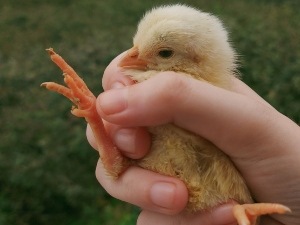
How your baby chick looks can tell you a lot about the health of the baby bird, including how the bird’s feathers look.
This article is a look into why your baby chick’s feathers look wet.
Table of Contents
Baby chick looks wet
One of the reasons why we think baby chicks are so cute is because of their soft and fluffy feathers.
These feathers are more delicate than adult chicken feathers and are distinct to chicks who are a few weeks old.
But if these fluffy feathers start to look oily you’ll know that you have a problem on your hands. Here is why this may be happening:
They are dirty:
When they are old enough your young chicks will start to produce oil from their preen gland, the preen gland is close to the bird’s vent, and birds use this oil to preen themselves.
Preening removes any dirt from their feathers and also keeps their skin and bill supple.
However, if the birds are really dirty for some reason then the bird will produce more oil to preen itself with and this oil may be all over the bird’s feathers making it look wet all the time
What to do:
Your baby chicks will get dirty but if the dirt on your bird’s feathers is causing it to overproduce oil then you may have to bathe your bird yourself.
The bird may have poop, or something else that is difficult to remove, stuck to their feathers that need water to remove
Remedy this problem by giving your bird a warm water bath and then dry the bird off afterward, do not use any soaps or any other detergents in the bird’s bath, these are not necessary.
Mites:
Another reason why your bird may look wet may be that the bird has mites. The northern fowl mite in particular.
These are very small mites that feed on blood and may have infected your chick. If infected, your chicks will develop a greasy look on their feathers because of the fecal deposits left by the mites.
In addition to your bird’s feathers looking oily, the bird may be suffering from other symptoms like very irritated skin.
The bird will bite at its skin or scratch itself against objects to relieve itself of the irritation.
What to do:
This infection needs to be dealt with as soon as possible if not the mites can kill the bird within a number of days.
Have a look at the bird around the vent to see if it does in fact have mites. Pick the bird up and part the feathers at the base of the bird’s tail to see if mites exist.
You’ll see tiny black mites, about 0.6 to 1mm in length, in the area if the bird is suffering from this condition. You may need a flashlight when doing this. Take your bird to the vet if you see this.
Treating the bird with over-the-counter treatments is not recommended as they may not work in time, so taking the bird to the vet for an examination and treatment is recommended.
Once the vet has checked and treated your bird, and the mites are gone, you’d need to make sure that the bird gets regular dust baths to keep mite infections, and other parasite infections, at bay.
If you enjoyed this article then you may also be interested in other bird related articles. Here are some articles that you may be interested in: Baby Chick Wants To Be Held All The Time, White Spots On Cockatiel Beak, Baby Chick Screaming, Baby Chick Distress Call, Chicken Stuck On Back, Red Rash On Chickens Skin, Chickens With Red Skin, Baby Chick Laying Down With Wing Out, Baby Chick Won’t Walk Or Open Eyes?


